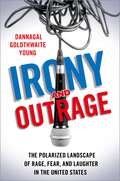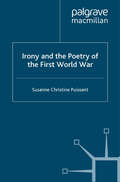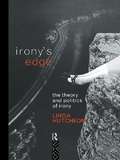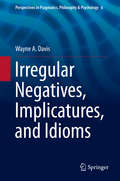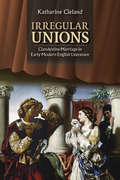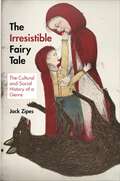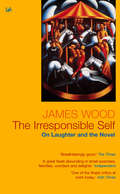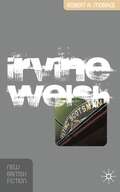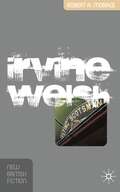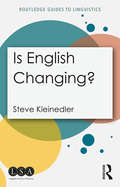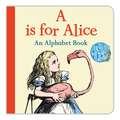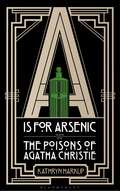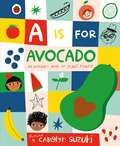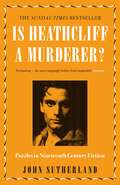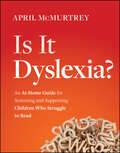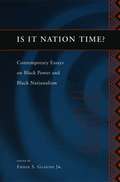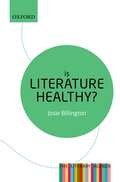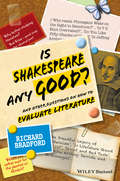- Table View
- List View
Irony and Outrage: The Polarized Landscape of Rage, Fear, and Laughter in the United States
by Dannagal Goldthwaite YoungFor almost a decade, journalists and pundits have been asking why we don't see successful examples of political satire from conservatives or of opinion talk radio from liberals. This book turns that question on its head to argue that opinion talk is the political satire of the right and political satire is the opinion programming of the left. They look and feel like two different animals because their audiences are literally, two different animals. In Irony and Outrage, political and media psychologist Dannagal Goldthwaite Young explores the aesthetics, underlying logics, and histories of these two seemingly distinct genres, making the case that they should be thought of as the logical extensions of the psychology of the left and right, respectively. One genre is guided by ambiguity, play, deliberation, and openness, while the other is guided by certainty, vigilance, instinct, and boundaries. While the audiences for Sean Hannity and John Oliver come from opposing political ideologies, both are high in political interest, knowledge, and engagement, and both lack faith in many of our core democratic institutions. Young argues that the roles that these two genres play for their viewers are strikingly similar: galvanizing the opinion of the left or the right, mobilizing citizens around certain causes, and expressing a frustration with traditional news coverage while offering alternative sources of information and meaning. One key way in which they differ, however, concludes Young, is in their capacity to be exploited by special interests and political elites. Drawing on decades of research on political and media psychology and media effects, as well as historical accounts and interviews with comedians and comedy writers, Young unpacks satire's liberal "bias" and juxtaposes it with that of outrage's conservative "bias." She details how traits like tolerance for ambiguity and the motivation to engage with complex ideas shape our preferences for art, music, and literature; and how those same traits correlate with political ideology. In turn, she illustrates how these traits help explain why liberals and conservatives vary in the genres of political information they prefer to create and consume.
Irony and the Poetry of the First World War
by S. PuissantHow does irony affect the evaluation and perception of the First World War both then and now? Irony and the Poetry of the First World War traces one of the major features of war poetry from the author's application as a means of disguise, criticism or psychological therapy to its perception and interpretation by the reader.
Irony's Edge: The Theory and Politics of Irony
by Linda HutcheonThe edge of irony, says Linda Hutcheon, is always a social and political edge. Irony depends upon interpretation; it happens in the tricky, unpredictable space between expression and understanding. Irony's Edge is a fascinating, compulsively readable study of the myriad forms and the effects of irony. It sets out, for the first time, a sustained, clear analysis of the theory and the political contexts of irony, using a wide range of references from contemporary culture. Examples extend from Madonna to Wagner, from a clever quip in conversation to a contentious exhibition in a museum. Irony's Edge outlines and then challenges all the major existing theories of irony, providing the most comprehensive and critically challengin theory of irony to date.
Irony's Edge: The Theory and Politics of Irony
by Linda HutcheonThe edge of irony, says Linda Hutcheon, is always a social and political edge. Irony depends upon interpretation; it happens in the tricky, unpredictable space between expression and understanding. Irony's Edge is a fascinating, compulsively readable study of the myriad forms and the effects of irony. It sets out, for the first time, a sustained, clear analysis of the theory and the political contexts of irony, using a wide range of references from contemporary culture. Examples extend from Madonna to Wagner, from a clever quip in conversation to a contentious exhibition in a museum. Irony's Edge outlines and then challenges all the major existing theories of irony, providing the most comprehensive and critically challengin theory of irony to date.
Irregular Negatives, Implicatures, and Idioms: Beyond Implicature And Explicature Theories (Perspectives in Pragmatics, Philosophy & Psychology #6)
by Wayne A. DavisThe author integrates, expands, and deepens his previous publications about irregular (or “metalinguistic”) negations. A total of ten distinct negatives—several previously unclassified—are analyzed. The logically irregular negations deny different implicatures of their root. All are partially non-compositional but completely conventional.The author argues that two of the irregular negative meanings are implicatures. The others are semantically rather than pragmatically ambiguous. Since their ambiguity is neither lexical nor structural, direct irregular negatives satisfy the standard definition of idioms as syntactically complex expressions whose meaning is non-compositional. Unlike stereotypical idioms, idiomatic negatives lack fixed syntactic forms and are highly compositional. The final chapter analyzes other “free form” idioms, including irregular interrogatives and comparatives, self-restricted verb phrases, numerical verb phrases, and transparent propositional attitude and speech act reports.
Irregular Unions: Clandestine Marriage in Early Modern English Literature
by Katharine ClelandKatharine Cleland's Irregular Unions provides the first sustained literary history of clandestine marriage in early modern England and reveals its controversial nature in the wake of the Elizabethan Religious Settlement, which standardized the marriage ritual for the first time. Cleland examines many examples of clandestine marriage across genres. Discussing such classic works as The Faerie Queene, Othello, and The Merchant of Venice, she argues that early modern authors used clandestine marriage to explore the intersection between the self and the marriage ritual in post-Reformation England.The ways in which authors grappled with the political and social complexities of clandestine marriage, Cleland finds, suggest that these narratives were far more than interesting plot devices or scandalous stories ripped from the headlines. Instead, after the Reformation, fictions of clandestine marriage allowed early modern authors to explore topics of identity formation in new and different ways.Thanks to generous funding from Virginia Tech and its participation in TOME (Toward an Open Monograph Ecosystem), the ebook editions of this book are available as Open Access volumes from Cornell Open (cornellopen.org) and other repositories.
The Irresistible Fairy Tale: The Cultural and Social History of a Genre
by Jack ZipesIf there is one genre that has captured the imagination of people in all walks of life throughout the world, it is the fairy tale. Yet we still have great difficulty understanding how it originated, evolved, and spread--or why so many people cannot resist its appeal, no matter how it changes or what form it takes. In this book, renowned fairy-tale expert Jack Zipes presents a provocative new theory about why fairy tales were created and retold--and why they became such an indelible and infinitely adaptable part of cultures around the world. Drawing on cognitive science, evolutionary theory, anthropology, psychology, literary theory, and other fields, Zipes presents a nuanced argument about how fairy tales originated in ancient oral cultures, how they evolved through the rise of literary culture and print, and how, in our own time, they continue to change through their adaptation in an ever-growing variety of media. In making his case, Zipes considers a wide range of fascinating examples, including fairy tales told, collected, and written by women in the nineteenth century; Catherine Breillat's film adaptation of Perrault's "Bluebeard"; and contemporary fairy-tale drawings, paintings, sculptures, and photographs that critique canonical print versions. While we may never be able to fully explain fairy tales, The Irresistible Fairy Tale provides a powerful theory of how and why they evolved--and why we still use them to make meaning of our lives.
The Irresistible Fairy Tale: The Cultural and Social History of a Genre
by Jack ZipesIf there is one genre that has captured the imagination of people in all walks of life throughout the world, it is the fairy tale. Yet we still have great difficulty understanding how it originated, evolved, and spread--or why so many people cannot resist its appeal, no matter how it changes or what form it takes. In this book, renowned fairy-tale expert Jack Zipes presents a provocative new theory about why fairy tales were created and retold--and why they became such an indelible and infinitely adaptable part of cultures around the world. Drawing on cognitive science, evolutionary theory, anthropology, psychology, literary theory, and other fields, Zipes presents a nuanced argument about how fairy tales originated in ancient oral cultures, how they evolved through the rise of literary culture and print, and how, in our own time, they continue to change through their adaptation in an ever-growing variety of media. In making his case, Zipes considers a wide range of fascinating examples, including fairy tales told, collected, and written by women in the nineteenth century; Catherine Breillat's film adaptation of Perrault's "Bluebeard"; and contemporary fairy-tale drawings, paintings, sculptures, and photographs that critique canonical print versions. While we may never be able to fully explain fairy tales, The Irresistible Fairy Tale provides a powerful theory of how and why they evolved--and why we still use them to make meaning of our lives.
The Irresponsible Self: On Laughter and the Novel
by James WoodWhen James Wood's first collection of essays, The Broken Estate, was published in 1999, the reviewers hailed a master critic. The common thread in Wood's latest collection of essays is what makes us laugh - and the book is an attempt to distinguish between the perhaps rather limited English comedy (as seen in Waugh, for example) and a 'continental' tragic-comedy, which he sees as real, universal and quixotic. A particularly acerbic, and very funny, essay - which has been widely celebrated - deals with Zadie Smith, Rushdie, Pynchon and DeLillo; its title, 'Hysterical Realism', has already entered the phrasebook of literary language. With its brilliant studies of Shakespeare, Dickens and Dostoevsky, Naipaul, Pritchett and Bellow, The Irresponsible Self offers more exhilarating despatches from one of our finest living critics.
Irvine Welsh (Contemporary British Novelists)
by Aaron KellyIrvine Welsh's fiction has defined an era, and this first full-length study provides a sustained textual and contextual analysis of all his work, from 'Trainspotting' and 'The Acid House' to 'Glue' and 'Porno'. A detailed chronological survey also considers the appropriateness of cultural, postmodern and postcolonial theories to Welsh's incendiary fiction.Kelly gives a fascinating insight into the writer's formal and political ambitions, placing him in the context of the 'brat pack' which exploded onto the Scottish literary scene in the 1990s. He explores the social, class and political conditioning of Welsh's early life, and its impact on his motivations for writing.Clearly written and accessible, this will be a key resource for students and academics alike. Choose 'Irvine Welsh'!
Irvine Welsh (New British Fiction)
by Robert MoraceThis book provides an introduction to the work of Irvine Welsh, placing his fiction in historical and theoretical context. It explores Welsh's biography, his impact on contemporary Scottish fiction and the cultural relevance of his work. Including a timeline of key dates, it also offers an overview of the critical reception his work has provoked
Irvine Welsh (New British Fiction)
by Robert MoraceThis book provides an introduction to the work of Irvine Welsh, placing his fiction in historical and theoretical context. It explores Welsh's biography, his impact on contemporary Scottish fiction and the cultural relevance of his work. Including a timeline of key dates, it also offers an overview of the critical reception his work has provoked
Is English Changing? (Routledge Guides to Linguistics)
by Steve KleinedlerIs English changing? To what degree is it changing? Is this change good or bad? In answering these questions, Is English Changing? provides a lively and concise introduction to language change, refuting commonly held misconceptions about language evolution as we understand it. Showing that English, like all living languages, has historically changed and continues to change, this book: analyzes developments in the lexicon, the way words are spoken or written, and the way in which speakers and writers use words; offers a basic overview of the major subfields of linguistics, including phonetics, morphology, syntax, semantics, pragmatics, and sociolinguistics, all viewed through the prism of language change; discusses change over time with examples from Old English, Middle English, and Modern English; reinforces important concepts with examples from other languages, including Spanish, Japanese, and Czech; clearly defines key terms and includes advice on rules, usage, and style, as well as ample annotated further reading and activities throughout. Aimed at undergraduate students with little or no prior knowledge of linguistics, this book is essential reading for those studying this topic for the first time.
Is English Changing? (Routledge Guides to Linguistics)
by Steve KleinedlerIs English changing? To what degree is it changing? Is this change good or bad? In answering these questions, Is English Changing? provides a lively and concise introduction to language change, refuting commonly held misconceptions about language evolution as we understand it. Showing that English, like all living languages, has historically changed and continues to change, this book: analyzes developments in the lexicon, the way words are spoken or written, and the way in which speakers and writers use words; offers a basic overview of the major subfields of linguistics, including phonetics, morphology, syntax, semantics, pragmatics, and sociolinguistics, all viewed through the prism of language change; discusses change over time with examples from Old English, Middle English, and Modern English; reinforces important concepts with examples from other languages, including Spanish, Japanese, and Czech; clearly defines key terms and includes advice on rules, usage, and style, as well as ample annotated further reading and activities throughout. Aimed at undergraduate students with little or no prior knowledge of linguistics, this book is essential reading for those studying this topic for the first time.
A is for Alice: An Alphabet Book
by Lewis CarrollA is for Alice: An Alphabet Book is a delightful introduction to the alphabet, using characters and objects from Lewis Carroll's iconic Alice's Adventures in Wonderland and Through the Looking-Glass. A is for Alice, E is for for Egg (Humpty Dumpty of course), Q is for the Queen, not forgetting R for the Rabbit who started off the whole adventure. With charming, traditional colour illustrations by Sir John Tenniel and beautiful Victorian-style decorations and backgrounds, this is a really special book for young children and, together with One White Rabbit: A Counting Book, forms a classy introduction to the classic Macmillan Alice.
A is for Arsenic: The Poisons of Agatha Christie
by Kathryn HarkupShortlisted for the BMA Book Awards and Macavity Awards 2016Fourteen novels. Fourteen poisons. Just because it's fiction doesn't mean it's all made-up ...Agatha Christie revelled in the use of poison to kill off unfortunate victims in her books; indeed, she employed it more than any other murder method, with the poison itself often being a central part of the novel. Her choice of deadly substances was far from random – the characteristics of each often provide vital clues to the discovery of the murderer. With gunshots or stabbings the cause of death is obvious, but this is not the case with poisons. How is it that some compounds prove so deadly, and in such tiny amounts?Christie's extensive chemical knowledge provides the backdrop for A is for Arsenic, in which Kathryn Harkup investigates the poisons used by the murderer in fourteen classic Agatha Christie mysteries. It looks at why certain chemicals kill, how they interact with the body, the cases that may have inspired Christie, and the feasibility of obtaining, administering and detecting these poisons, both at the time the novel was written and today. A is for Arsenic is a celebration of the use of science by the undisputed Queen of Crime.
A is for Avocado: An Alphabet Book of Plant Power
by Carolyn SuzukiPerfect picture alphabet for young vegans, vegetarians, curious minds and fussy eaters. The rise in veganism and vegetarianism as well as an increased interest in the environment has meant that more children and adults are developing a greater appreciation for what they eat and where it comes from. This stylish gift book introduces young readers to twenty-six fresh fruits, vibrant vegetables and powerful plants, from avocado to zucchini. Each letter of the alphabet is represented by a plant or plant-based product and accompanied by a fascinating fact, with the aim to show that there is more to the fruits and vegetables that we see everyday. Content includes: Avocado: The Aztecs used these rich, creamy fruits as a symbol of love. Bean: There are around 40,000 different types of these edible seeds. Carrot: Carrots contain beta-carotene, a chemical that can improve your eyesight. Durian: This strong-smelling fruit is highly prized throughout South East Asia. Elderberry: These tart berries grow in clusters and are harvested in the autumn. Carolyn Suzuki's bright, stylist artwork enhances and engages the reader to make A is for Avocado the perfect introduction to plant-based foods for all ages.
Is Heathcliff a Murderer?: Puzzles in Nineteenth-Century Fiction (Oxford World's Classics Ser.)
by John SutherlandTHE SUNDAY TIMES BESTSELLER IN A BRAND NEW EDITION 'Enchanting...the most engagingly boffiny book imaginable.' Spectator Does Becky kill Jos at the end of Vanity Fair? Why does no one notice that Hetty is pregnant in Adam Bede? How, exactly, does Victor Frankenstein make his monster? Readers of Victorian fiction often find themselves tripping up on seeming anomalies, enigmas and mysteries in their favourite novels. In Is Heathcliff a Murderer? John Sutherland investigates 34 conundrums of nineteenth-century fiction, paying homage to the most rewarding of critical activities: close reading and the pleasures of good-natured pedantry
Is It Dyslexia?: An At-Home Guide for Screening and Supporting Children Who Struggle to Read
by April McMurtreyHands-on resources for screening readers of all ages for dyslexia In Is It Dyslexia?, certified dyslexia assessment specialist April McMurtrey delivers an accessible, hands-on framework for screening readers of various ages for dyslexia.. The book offers comprehensive, clear, and step-by-step processes you can apply immediately to confidently and accurately screen readersfor dyslexia. The author shares the tools and strategies used by professional screeners, as well as first, next, and final steps you can take as you move forward with your screening results. The book includes: Explanations of what dyslexia is, as well as an overview of common talents and strengths often found in readers with dyslexia A collection of recommended accommodations for students with dyslexia in the home and school and effective literacy instruction for students with dyslexia A comprehensive dyslexia questionnaire, eleven different screening tests, and step-by-step instructions for administering themIdeal for tutors, homeschool teachers, parents, instructional coaches, counselors, and speech-language therapists, Is It Dyslexia? comes complete with reproducibles and links to video tutorials required for screening students of various ages.
Is It Dyslexia?: An At-Home Guide for Screening and Supporting Children Who Struggle to Read
by April McMurtreyHands-on resources for screening readers of all ages for dyslexia In Is It Dyslexia?, certified dyslexia assessment specialist April McMurtrey delivers an accessible, hands-on framework for screening readers of various ages for dyslexia.. The book offers comprehensive, clear, and step-by-step processes you can apply immediately to confidently and accurately screen readersfor dyslexia. The author shares the tools and strategies used by professional screeners, as well as first, next, and final steps you can take as you move forward with your screening results. The book includes: Explanations of what dyslexia is, as well as an overview of common talents and strengths often found in readers with dyslexia A collection of recommended accommodations for students with dyslexia in the home and school and effective literacy instruction for students with dyslexia A comprehensive dyslexia questionnaire, eleven different screening tests, and step-by-step instructions for administering themIdeal for tutors, homeschool teachers, parents, instructional coaches, counselors, and speech-language therapists, Is It Dyslexia? comes complete with reproducibles and links to video tutorials required for screening students of various ages.
Is It Nation Time?: Contemporary Essays on Black Power and Black Nationalism
by Eddie S. GlaudeDuring the late 1960s and early 1970s, the Black Power movement provided the dominant ideological framework through which many young, poor, and middle-class blacks made sense of their lives and articulated a political vision for their futures. The legacy of the movement is still very much with us today in the various strands of black nationalism that originated from it; we witnessed its power in the 1995 Million Man March, and we see its more ambiguous effects in the persistent antagonisms among former participants in the civil rights coalition. Yet despite the importance of the Black Power movement, very few in-depth, balanced treatments of it exist. Is It Nation Time? gathers new and classic essays on the Black Power movement and its legacy by renowned thinkers who deal rigorously and unsentimentally with such issues as the commodification of blackness, the piety of cultural recovery, and class tensions within the movement. For anyone who wants to understand the roots of the complex political and cultural desires of contemporary black America, this will be an essential collection. Contributors: Eddie S. Glaude Jr. Farah Jasmine Griffin Phillip Brian Harper Gerald Horne Robin D. G. Kelley Wahneema Lubiano Adolph Reed Jr. Jeffrey Stout Will Walker S. Craig Watkins Cornel West E. Francis White
Is Literature Healthy?: The Literary Agenda (The Literary Agenda)
by Josie BillingtonThe Literary Agenda is a series of short polemical monographs about the importance of literature and of reading in the wider world and about the state of literary education inside schools and universities. The category of 'the literary' has always been contentious. What is clear, however, is how increasingly it is dismissed or is unrecognised as a way of thinking or an arena for thought. It is sceptically challenged from within, for example, by the sometimes rival claims of cultural history, contextualized explanation, or media studies. It is shaken from without by even greater pressures: by economic exigency and the severe social attitudes that can follow from it; by technological change that may leave the traditional forms of serious human communication looking merely antiquated. For just these reasons this is the right time for renewal, to start reinvigorated work into the meaning and value of literary reading. Medical Humanities comprises disciplines as diverse as literature, the visual and performing arts, the history of medicine, bioethics. It claims a vast range of philosophical and political agendas, goals and purposes, including the education of medical students in areas of clinical empathy, critical thinking, ethical awareness, gender and race issues and cross-cultural medicine. Josie Billington argues that in so far as literature is offered as adding value to medical education in health training and practice, that defence tends to become instrumental in nature, whether consciously and explicitly, or otherwise. This book is interested, more widely, in the power of the arts as a remedial force. Following an introduction surveying the idea of the Medical Humanities, its history, and its development, the book's four chapters will look at illness and health as defined in medical terms and as complicated within the field of imaginative literature; at narrative and storytelling within the therapeutic meeting of medical and literary approaches; at reading groups and private reading, considering contemporary models of literary reading as a template for redefining literature's place and power not only within the discipline of Medical Humanities but within the wider world in relation to concerns of mental wellbeing that affect us all.
Is Literature Healthy?: The Literary Agenda (The Literary Agenda)
by Josie BillingtonThe Literary Agenda is a series of short polemical monographs about the importance of literature and of reading in the wider world and about the state of literary education inside schools and universities. The category of 'the literary' has always been contentious. What is clear, however, is how increasingly it is dismissed or is unrecognised as a way of thinking or an arena for thought. It is sceptically challenged from within, for example, by the sometimes rival claims of cultural history, contextualized explanation, or media studies. It is shaken from without by even greater pressures: by economic exigency and the severe social attitudes that can follow from it; by technological change that may leave the traditional forms of serious human communication looking merely antiquated. For just these reasons this is the right time for renewal, to start reinvigorated work into the meaning and value of literary reading. Medical Humanities comprises disciplines as diverse as literature, the visual and performing arts, the history of medicine, bioethics. It claims a vast range of philosophical and political agendas, goals and purposes, including the education of medical students in areas of clinical empathy, critical thinking, ethical awareness, gender and race issues and cross-cultural medicine. Josie Billington argues that in so far as literature is offered as adding value to medical education in health training and practice, that defence tends to become instrumental in nature, whether consciously and explicitly, or otherwise. This book is interested, more widely, in the power of the arts as a remedial force. Following an introduction surveying the idea of the Medical Humanities, its history, and its development, the book's four chapters will look at illness and health as defined in medical terms and as complicated within the field of imaginative literature; at narrative and storytelling within the therapeutic meeting of medical and literary approaches; at reading groups and private reading, considering contemporary models of literary reading as a template for redefining literature's place and power not only within the discipline of Medical Humanities but within the wider world in relation to concerns of mental wellbeing that affect us all.
Is Shakespeare any Good?: And Other Questions on How to Evaluate Literature
by Richard BradfordIs Shakespeare any Good? reveals why certain literary works and authors are treated as superior to others, and questions the literary establishment’s criteria for creating an imperium of “great” writers. Enables readers to articulate and formulate their own arguments about the quality of literature – including works that convention forbids us to dislike Dismantles the claims of academic criticism – particularly Theory – to tell us anything useful about why we like or appreciate literature Challenges and shatters many longstanding beliefs about literature and its evaluation Poses serious questions about the value of literature, and studying literature, and presents these in a lively and entertainingly provocative manner
Is Shakespeare any Good?: And Other Questions on How to Evaluate Literature
by Richard BradfordIs Shakespeare any Good? reveals why certain literary works and authors are treated as superior to others, and questions the literary establishment’s criteria for creating an imperium of “great” writers. Enables readers to articulate and formulate their own arguments about the quality of literature – including works that convention forbids us to dislike Dismantles the claims of academic criticism – particularly Theory – to tell us anything useful about why we like or appreciate literature Challenges and shatters many longstanding beliefs about literature and its evaluation Poses serious questions about the value of literature, and studying literature, and presents these in a lively and entertainingly provocative manner
